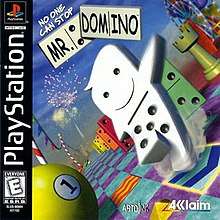No One Can Stop Mr. Domino!
No One Can Stop Mr. Domino![lower-alpha 1] is a puzzle video game developed by Artdink and released for the PlayStation in 1998. The user controls one of five anthropomorphic dominoes, placing other dominoes in rows that will successfully topple while avoiding obstacles and working under a time limit.
| No One Can Stop Mr. Domino! | |
|---|---|
 | |
| Developer(s) | Artdink |
| Publisher(s) |
|
| Director(s) | Tomotsu Satō |
| Producer(s) | Masahisa Okamoto |
| Programmer(s) | Tatsuo Oku |
| Artist(s) | Shuji Kasai |
| Composer(s) | Shingo Murakami |
| Platform(s) | PlayStation |
| Release | |
| Genre(s) | Endless runner, Puzzle |
| Mode(s) | Single-player |
Gameplay
The game includes 6 stages: a casino, a grocery store, a family home, a local park, an amusement park, and a city. Each stage is set up like a racetrack as the character will go back to the starting point after each lap. The player can make as many laps as needed to clear a given stage. When the level is cleared, the player will proceed to the next stage.
Once a stage starts, the character will start to run, and he/she will not stop running. To control the character's speed and where he runs, the player dictates movement with the D-Pad. The characters that are not under the player's control will attempt to hinder the avatar's progress in ways such as throwing dice, turning on electrical wire, and making fruit appear out of nowhere; making the evasion of such obstacles a primary concern of the player.
A game element called a "trick tile", places the dominoes effectively by input of the Circle, X, Triangle, or Square button. This will place a domino on the current path. The player can continue to keep placing dominoes by holding down one of the aforementioned buttons.
When a full lap is completed around the stage and returned to where the first domino was laid, the character will bump into the domino. The dominoes will begin an effect of inertia, and the character will stand still while the dominoes are falling.
While active, the character's stamina will decrease. This is signified by the character's body gradually darkening. If the character's stamina is depleted, the character will transform into an ordinary domino, and the game will end. This is prevented by encountering special Recovery Tiles that can recover the character's stamina, but can only be used once for each tile.
The player clears a stage by activation of the required number of trick tiles for each stage. The player heightens their score by activating the trick tiles in a shorter time and in as long of a chain as possible. If the stage is cleared with a High Score, the player will be able to unlock new characters.
Characters
- Mr. Domino is the titular character of the game, and one of the two characters that are selectable in the beginning. He runs at normal speed.
- Miss Domino is one of the two characters that are selectable in the beginning of the game. She skips rather than runs.
- Bruce is a Domino with devil horns. He is difficult to handle due to his fast running speed. For advanced players only.
- Pierre-Domino is a Domino with glasses. He is the opposite of Bruce, as he runs slowly and runs out of breath quickly.
- D△M•?0 is an alien Domino with an unknown style. It is also the fastest of all of the dominoes.
Reception
| Reception | ||||||||||||||||||||||||||
|---|---|---|---|---|---|---|---|---|---|---|---|---|---|---|---|---|---|---|---|---|---|---|---|---|---|---|
| ||||||||||||||||||||||||||
The game received "average" reviews according to the review aggregation website GameRankings.[2] In Japan, Famitsu gave it a score of 25 out of 40.[5] Next Generation said that "for puzzle-savvy players, the combination of technique, luck, quirky surrealism, and clever designs in Mr. Domino gives the game just enough of a hook to incite addiction."[9]
References
- Known as Do Not Stop Domino-kun (ドミノ君をとめないで。, Domino-kun wo Tomenaide) in Japan
- Cove, Glen (November 30, 1998). "Mr. Domino". Archived from the original on August 25, 2004.
- "No One Can Stop Mr. Domino for PlayStation". GameRankings. CBS Interactive. Retrieved May 13, 2014.
- Sackenheim, Shawn. "No One Can Stop Mr. Domino - Review". AllGame. All Media Network. Archived from the original on November 15, 2014. Retrieved December 9, 2016.
- "No One Can Stop Mr. Domino!". Electronic Gaming Monthly. Ziff Davis. January 1999.
- "ドミノ君をとめないで。 [PS]". Famitsu (in Japanese). Enterbrain. Retrieved July 17, 2018.
- "No One Can Stop Mr. Domino!". Game Informer. No. 69. FuncoLand. January 1999. p. 72.
- Bartholow, Peter (December 14, 1998). "No One Can Stop Mr. Domino! Review". GameSpot. CBS Interactive. Retrieved December 9, 2016.
- Perry, Douglass C. (December 2, 1998). "No One Can Stop Mr. Domino". IGN. Ziff Davis. Retrieved December 9, 2016.
- "No One Can Stop Mr. Domino!". Next Generation. No. 51. Imagine Media. March 1999. p. 90. Retrieved February 5, 2020.
- "No One Can Stop Mr. Domino". PSM. No. 18. Imagine Media. February 1999. p. 37. Retrieved February 5, 2020.